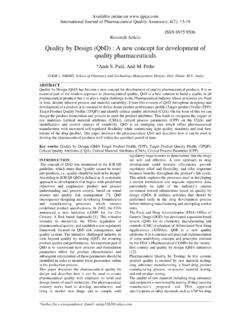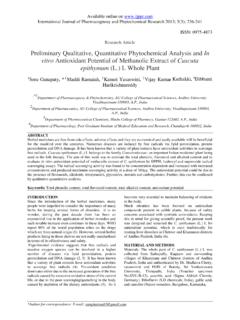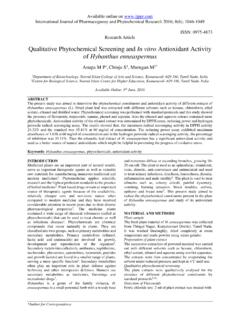Transcription of Management of Out of Specification (OOS) for Finished Product
1 Online at International Journal of Pharmaceutical and Clinical Research 2017; 9(3): 221-232 doi: ISSN- 0975 1556 Research Article *Author for Correspondence: Management of Out of Specification (OOS) for Finished Product Ravi Kiran S N, Gowrav M P*, Gangadharappa H V, G Ravi Department of Pharmaceutics, JSS College of Pharmacy, Sri Shivarathreeshwara Nagara, Jagadguru Sri Shivarathreeshwara University, JSS Medical Institutions Campus, Sri Shivarathreeshwara Nagara, Mysore-570015, Karnataka, India. Available Online: 25th March, 2017 ABSTRACT Background of the study: Difficult lies at the core of drug producer successful operation.
2 Laboratory testing , which is compulsory by the CGMP regulations are required to check that components, containers and closures, in-process materials, and Finished products conform to specifications, including stability specifications. Objective of the study: The objective of the investigation procedure should clearly state when the investigation is required, and define OOS, OOT, and aberrant results. OOS results are most often generated due to laboratory or manufacturing-related errors, the setting of inappropriate specifications, or poor method development.
3 Materials and Methods: The current work is an effort to deliberate several aspects of finding the root cause for the OOS during the Finished Product analysis by using HPLC. Results and Discussion: Product s individual unknown impurity was not in Specification limit and, hence study carried out to find the root cause. Conclusion: After conducting detail investigation it was proved that an analyst conducted the analysis of the Product after the due date to expiry. Keywords: Laboratory errors, Flow of investigation, Phases of investigation.
4 INTRODUCTION Laboratory errors Laboratory errors occur when analysts make mistakes in following the method of analysis, use incorrect standards, and/or simply miscalculate the data. Laboratory errors must be determined through a failure investigation to identify the cause of the OOS. Once the nature of the OOS result has been identified it can be classified into one of the three categories OOS, OOT, Atypical results. The enquiry may vary with the object under investigation1. In pharmaceutical industry, out-of- Specification (OOS) test results are results that (after rounding off) fall outside the specifications of established acceptance criteria.
5 By analogy, measurement or test results obtained in other industries and such fields as environmental and/or food analysis, which do not comply with regulatory, Specification or legislation limits, can be named also OOS test results. The problem of OOS test results was known for analysts working in quality control laboratories since the 1920s, but it was not understood until the 1990s that a lack of statistical and metrological thinking is the main aspect of the problem.
6 In 1993, Barr Laboratories (a generic-drug manufacturer) was used by US government regarding a set of issues influencing the Product quality, including the way the company dealt with OOS test results. Among the issues were averaging OOS with in- Specification test result values to get a passing result, conducting multiple retests with no defined end point, performing inadequate failure investigations, maintaining an ineffective program for process validation and lacking analytical method validation, etc.
7 Judge Wolin s ruling (the Barr Decision) was that following an OOS test result, an investigation must be initiated before any retesting can be done. Identifying OOS test results is described in the fda guidance as the laboratory (Phase 1) investigation2-4. It includes responsibility of the analyst and his or her supervisor, conditions of the testing in the laboratory, etc5. Identifying OOS test results using investigating tools in currently, the majority of analysts realize that the measurement uncertainty concept is very important because of necessity to balance the cost of measurements versus the Product quality risk.
8 For example, to assess compliance of a test result within legislation limits, the analyst should report not only an analyte concentration, but also the associated measurement uncertainty6,7. The value obtained by subtracting the uncertainty from the reported concentration is used to assess compliance with the upper legislation limit. When the compliance assessment is made on the basis of a measurement result accompanied by information on the uncertainty associated with the result, the rules Developed in the EURACHEM/CITAC Guide are applicable for identifying OOS test results.
9 Similar rules are included in the ILAC Guidelines. JCGM Guide on the role of measurement uncertainty in conformity assessment is under development8. After identification of an OOS test result, it is important to determine its root causes with the purpose to avoid any repetition of the occurrence when the appearance of a next OOS test result is possible or even inevitable9. The fda guidance formulates recommendations for such incidences including Ravi et al. / Management of IJPCR, Volume 9, Issue 3: March 2017 Page 222 production process review, additional laboratory testing using a pre-defined procedure, reporting testing results, and concluding the investigation with identification of the root causes.
10 Thus, this document establishes an empirical organizational approach to the full-scale (Phase 2) investigation and decisions which can be accepted at the different stages of this investigation10-12. MATERIALS AND METHODS Laboratory investigations The investigation must be Thorough Timely Unbiased Scientifically sound Well documented Matters that should be investigated for assignable cause Inadequate training of analysts Poorly maintained or improperly calibrated equipment Analysts not following procedures Procedures technically not appropriate Validated procedures Reagents Consumables Cleanliness of glassware Outcome is to Confirm if OOS is true OOS Determine source of OOS and Take corrective and preventative action







